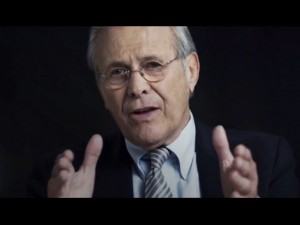The Unknown Known
Posted on April 3, 2014 at 5:59 pm
B+| Lowest Recommended Age: | Middle School |
| MPAA Rating: | Rated PG-13 for some disturbing images and brief nudity |
| Profanity: | Mild language |
| Alcohol/ Drugs: | None |
| Violence/ Scariness: | Wartime violence, terrorism, |
| Diversity Issues: | A theme of the movie |
| Date Released to Theaters: | April 3, 2014 |

Errol Morris turns his famous “interrotron” camera on two-time Secretary of Defense Donald Rumsfeld for something between a bookend and a counterpoint to his Oscar-winning The Fog of War: Eleven Lessons from the Life of Robert S. McNamara. But this SecDef (as they say in the Pentagon) is not here to confess or apologize even in part, as McNamara did.
He says, in the movie’s final exchange, that he is not sure why he agreed to submit to more than 30 hours of what must have felt more like the cross-examination in “A Few Good Men” or even a detainee interrogation than the back-and-forth press briefings Rumsfeld conducted during the early days of the wars in Iraq and Afghanistan. We see many clips from those celebrated exchanges, at the time referred to as the best show in Washington, and still undeniably entertaining. Rumsfeld’s good humor and confidence were bracing and reassuring at a time when everything seemed to be what he would call an unknown unknown. Like Jack Nicholson in “A Few Good Men” he does not think we can handle the truth. He may be right.
He’s not here to explain. What he is here to do is to repeat the same version of the story, despite the fact that the audience has had the benefit of making some of those unknowns more known.
Rumsfeld’s constant memos, perhaps 20,000 by his count over his final term at Defense, were called “snowflakes” by the staff, based on their color and frequency. It must have seemed like an avalanche. Morris shows us long shelves of folders filled with snowflakes. He has Rumsfeld read some portions aloud, beginning with his famous taxonomy of information. There were known knowns, things we know and know to be true. There were known unknowns, things we do not know and wish we did. There were unknown knowns, things we do not realize that we know. And unknown unknowns, things we don’t know and don’t know that we need to know. Yes.
But what we do with those categories is the tough part, especially when assigning facts. The boxes and labels are nice and neat. The things we do and do not know are not. Rumsfeld often seems Wittgensteinian when he calls for dictionary definitions or makes a distinction between a Pentagon term and standard English. But definitions are not answers.
“Pearl Harbor was a failure of imagination,” Rumsfeld says. So, we gather, was 9/11. Vietnam was “the inevitable ugly ending of an unsuccessful effort.” How do we not make that mistake again? How do we destroy terrorists without a Hydra effect, creating two more for every one we cut down? We might think those answers are known unknowns. But Rumsfeld does not have the luxury of waiting to be sure.
He tells us he found out the US was going to invade Iraq when he was called into a meeting with then-Vice President Dick Cheney (Rumsfeld’s former assistant in the Nixon White House), along with Saudi Ambassador Prince Bandar. And that he never read the Justice Department legal memos about “enhanced interrogation.” He insists that he never said and the American people never thought there was a connection between Saddam Hussein and the 9/11 attacks. Cut to tape of the press conference where he called Saddam a liar for denying there was a connection.
Rumsfeld is aware of the inherent conflicts. He cheerfully acknowledges the inconsistency between two principles: Belief in the inevitability of conflict can be one of its causes. And if you wish for peace, prepare for war. Plus: all generalizations are false, including this one. He sounds like a zen master, but a jolly one. His good humor can be disconcerting, but not chilling. At the time, it was reassuring to us and undeniably disconcerting to our enemies. Rumsfeld often seems exceptionally forthright, as when he calmly discusses his two offers to resign following the revelations of abuse at Abu Ghraib. Would you rather have someone in that job who is grim?
His demeanor comes across today as oddly disengaged. He tears up once, telling about a visit to a gravely injured soldier who was not expected to live, but who did. There are no stories about those who did not.
Morris sometimes overdoes it, with a celestial choir and a snow globe of the Washington Monument as repeated commentary/symbols. Repeated sped-up shots of traffic in Washington, obviously far after the events being discussed, add little.
One can’t help thinking that part of what draws Morris to this story is his own belief in the capacity for absolute truth, in its way as limited as Rumsfeld’s belief that he can tie down the unknown unknowns tightly enough to support a military strategy. Or disinfect a morally compromised decision. But then, how many decisions in wartime or in time of terrorism are not morally compromised? There are unknown knowns, and unknown unknowns, and there are also political and historical quagmires.
Parents should know that this film has disturbing subject matter and some graphic images of the victims of “enhanced interrogation” and abuse.
Family discussion: Once you have created the categories of “known knowns” and “known unknowns,” how do you know when you have enough information to decide? What qualities should one have to serve as Secretary of Defense? What surprised you about this version of the story and why?
If you like this, try: The Fog of War, No End in Sight
, also by Morris, and Taxi To the Dark Side
